AEG EWF935 User Manual [pt]
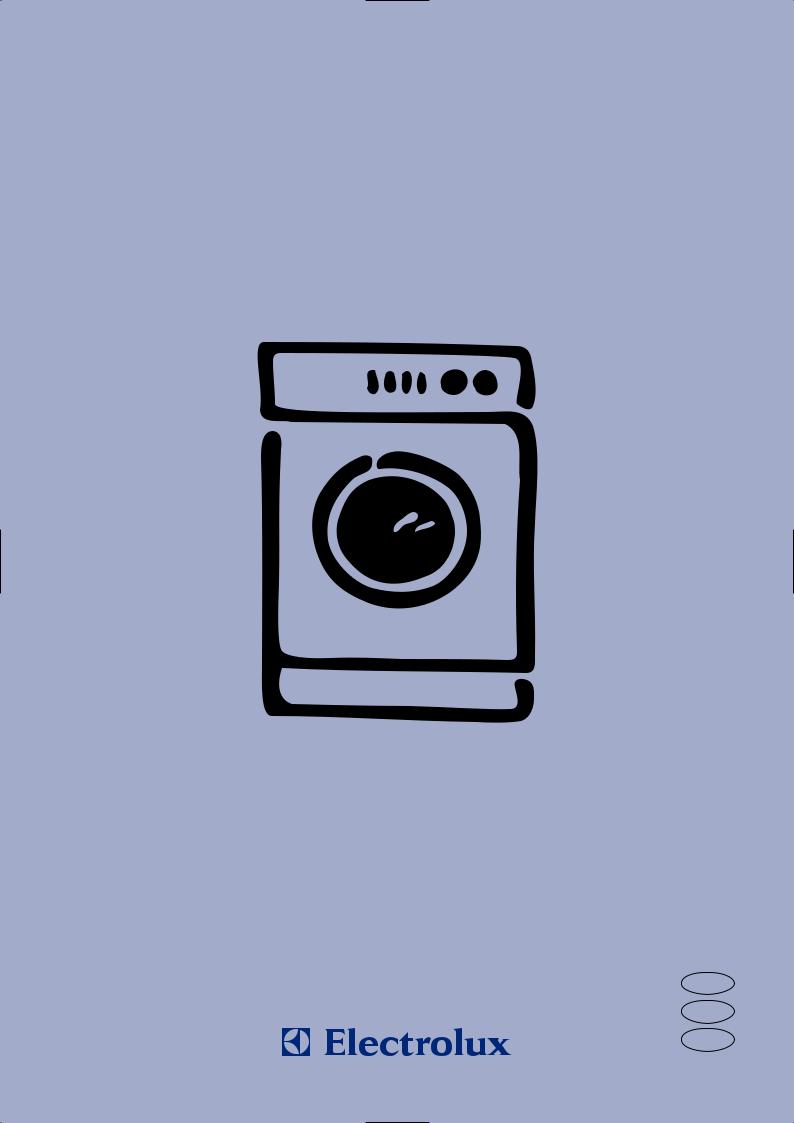
WASHING MACHINE
MÁQUINA DE LAVAR ROUPA
РЛХНФЗСЙП СПХЧЩН
INSTRUCTION BOOKLET MANUAL DE UTILIZAÇÃO
ЕГЧЕЙСЙДЙП ПДЗГЙЩН
EWF 735
EWF 935
EWF 1035
G B
P
G R
132 982 341

Dear customer,
Please read these operating instructions carefully and pay particular attention to the safety notes indicated in the first pages. We recommend that you keep this instruction booklet for future reference and pass it on to any future owners.
Transport damages
When unpacking the appliance, check that it is not damaged. If in doubt, do not use it and contact the Service Centre.
The symbols you will see on some paragraphs of this booklet have the following meaning:
The warning triangle and/or the key words (Warning!, Caution!) emphasize information that is particularly important for your safety or correct functioning of the appliance.
The information marked with this symbol provides additional instructions and practical tips on the use of the appliance.
Tips and information about economical and ecological use of the machine are marked with this symbol.
Our contribution to the protection of the environment: we use recycled paper.
2

Contents
Warnings |
4-5 |
Disposal |
5 |
Tips for environmental protection 5
Technical specifications |
6 |
Installation |
7 |
Unpacking |
7 |
Positioning |
7 |
Water inlet |
7-8 |
Assembly upon a stand kit |
8 |
Water drainage |
8 |
Electrical connection |
8 |
Your new washing machine |
9 |
Description of the appliance |
9 |
Detergent dispenser drawer |
9 |
Use |
10 |
Control panel |
10 |
Controls |
10-13 |
Washing hints |
14-15 |
Sorting the laundry |
14 |
Temperatures |
14 |
Before loading the laundry |
14 |
Maximum loads |
14 |
Laundry weights |
14 |
Removing stains |
14-15 |
Detergents and additives |
15 |
International wash code symbols |
16 |
Operating sequence |
17-19 |
Washing programmes |
20-22 |
Maintenance |
23-24 |
Bodywork |
23 |
Door seal |
23 |
Detergent dispenser drawer |
23 |
Drain pump |
23-24 |
Water inlet filter |
24 |
Emergency emptying out |
24 |
Frost precautions |
24 |
Something not working? |
25-26 |
ENGLISH
3
 Warnings
Warnings
The following warnings are provided in the interests of overall safety. You must read them carefully before installing or using the appliance.
Installation
•All internal packing must be removed before using the appliance. Serious damage may be caused to the machine or adjacent furniture if the protective transit devices are not removed or are not completely removed. Refer to the relevant paragraph in the instruction book.
•Any electrical work required to install this appliance must be carried out by a qualified electrician.
•Any plumbing work required to install this appliance must be carried out by a qualified plumber.
•After having installed the machine, check that it is not standing on its electrical supply cable.
•If the appliance is placed on a carpeted floor, ensure that air can circulate freely between the feet and the floor.
Use
•This appliance is designed for domestic use. It must not be used for purposes other than those for which it was designed.
•Only wash fabrics which are designed to be machine washed. Follow the instructions on each garment label.
•Do not overload the appliance. Follow the instructions in the instruction book.
•Make sure that all pockets are empty. Objects such as coins, safety pins, pins and screws can cause extensive damage.
•Do not machine wash garments saturated with petroleum, methylated spirits, trichlorethylene, etc. If such fluids have been used to remove stains prior to washing, wait until they have completely evaporated from the fabric before placing garments in the appliance.
•Place small items such as socks, belts, etc. in a cloth bag or pillowcase to prevent them getting trapped between the drum and the tub.
•Use only the recommended quantities of fabric softener. An excessive amount could damage the laundry.
•Leave the porthole door slightly ajar when the appliance is not in use. This preserves the door seal and prevents the formation of musty smells.
•Always check that water has emptied out before opening the door. If not, drain the water following the instructions in the instruction book.
•Always unplug the appliance and shut the water tap after use.
General safety
•Repairs to the machine must be carried out only by qualified personnel. Repairs carried out by inexperienced persons could cause serious danger. Contact your local Service Centre.
•Never pull the power supply cable to remove the plug from the socket; always take hold of the plug itself.
•During high temperature wash programmes the door glass may get hot. Do not touch it!
4

Child safety
•Children are often not aware of how dangerous electrical appliances can be. When the machine is working, children should be carefully supervised and not be allowed to play with the appliance.
•The packaging components (e.g. plastic film, polystyrene) can be dangerous to children - danger of suffocation! Keep them out of children’s reach.
•Keep all detergents in a safe place out of children’s reach.
•Make sure that children or pets do not climb into the drum. To avoid this the machine incorporates a special feature. To activate this device, rotate the button (without pressing it) inside the door clockwise until the groove is horizontal. If necessary use a coin.
To disable this device and restore the possibility of closing the door, rotate the button anti-clockwise until the groove is vertical.
P1131 |
•When the appliance is to be scrapped, cut off the electrical supply cable and destroy the plug with the remaining cable. Disable the door catch in order to prevent children from becoming trapped inside while playing.
 Disposal
Disposal
Packaging materials
The materials marked with the symbol 
 are recyclable.
are recyclable.
>PE<=polyethylene >PS<=polystyrene >PP<=polypropylene
This means that they can be recycled by disposing of them properly in appropriate collection containers.
Machine
Use authorised disposal sites for your old appliance. Help to keep your country tidy!
The symbol  on the product or on its packaging indicates that this product may not be treated as household waste. Instead it shall be handed over to the applicable collection point for the recycling of electrical and electronic equipment. By ensuring this product is disposed of correctly, you will help prevent potential negative consequences for the environment and human health, which could otherwise be caused by inappropriate waste handling of this product. For more detailed information about recycling of this product, please contact your local city office, your household waste disposal service or the shop where you purchased the product.
on the product or on its packaging indicates that this product may not be treated as household waste. Instead it shall be handed over to the applicable collection point for the recycling of electrical and electronic equipment. By ensuring this product is disposed of correctly, you will help prevent potential negative consequences for the environment and human health, which could otherwise be caused by inappropriate waste handling of this product. For more detailed information about recycling of this product, please contact your local city office, your household waste disposal service or the shop where you purchased the product.
 Tips for environmental protection
Tips for environmental protection
To save water, energy and to help protect the environment, we recommend that you follow these tips:
•Normally soiled laundry may be washed without prewashing in order to save detergent, water and time (the environment is protected too!).
•The machine works more economically if it is fully loaded.
•With adequate pre-treatment, stains and limited soiling can be removed; the laundry can then be washed at a lower temperature.
•Measure out detergent according to the water hardness, the degree of soiling and the quantity of laundry being washed.
ENGLISH
5

Technical specifications
DIMENSIONS |
Height |
85 cm |
|
|
Width |
60 cm |
|
|
Depth |
59 cm |
|
|
|
|
|
MAXIMUM LOAD |
Cotton |
6 |
kg |
|
Synthetics |
2,5 kg |
|
|
Delicates and miniprogramme |
2,5 kg |
|
|
Woollens and handwash |
2 |
kg |
|
Silk |
1 |
kg |
SPIN SPEED |
|
700 rpm max. (EWF 735) |
|
|
900 rpm max. (EWF 935) |
|
|
1000 rpm max. (EWF 1035) |
|
|
|
POWER SUPPLY VOLTAGE/FREQUENCY |
220-230 V/50 Hz |
|
TOTAL POWER ABSORBED |
|
2200 W |
MINIMUM FUSE PROTECTION |
|
10 A |
|
|
|
WATER PRESSURE |
Minimum |
0,05 MPa |
|
Maximum |
0,8 MPa |
This appliance complies with the following EEC Directives: 73/23/EEC of 19/02/73 relating to low voltage
89/336/EEC of 03/05/89 relating to electromagnetic compatibility.
6

Installation
Unpacking
All transit bolts and packing must be removed before using the appliance.
You are advised to keep all transit devices so that they can be refitted if the machine ever has to be transported again.
1.Using a spanner, unscrew and remove the two rear bottom screws. Slide out the two plastic pins.
P1129 |
P0001 |
2.Lay the machine on its back, taking care not to squash the hoses. This can be avoided by placing one of the corner packing pieces between the machine and the floor.
3.Remove the polystyrene block from the bottom of the machine and release the two plastic bags.
1 |
P1124 |
4.Very carefully slide out the left polythene bag, removing it towards the right and then downwards.
5.Very carefully slide out the right polythene bag, removing it towards the left and then upwards.
P1126 |
P1127 |
6.Set the machine upright and remove the remaining rear screw. Slide out the relevant pin.
7.Plug all the holes with the plugs which you will find in the envelope containing the instruction booklet.
P1128 |
P0002 |
Positioning |
|
Install the machine on a flat hard floor.
Make sure that air circulation around the machine is not impeded by carpets, rugs etc. Check that the machine does not touch the wall or other kitchen units.
Carefully level by screwing the adjustable feet in or out. Never place cardboard, wood or similar materials under the machine to compensate for any unevenness in the floor.
P1051 |
Water inlet
Connect the water inlet hose to a tap with a 3/4" thread.
Do not use already employed hoses for water connection.
P1088 |
The other end of the inlet hose which connects to the machine can be turned in any direction. Simply loosen the fitting, rotate the hose and retighten the fitting, making sure there are no water leaks.
ENGLISH
7

P0021 |
The inlet hose must not be lengthened. If it is too short and you do not wish to move the tap, you will have to purchase a new, longer hose specially designed for this type of use.
Important!
Before connecting up the machine to new pipework or to pipework that has not been used for some time, run off a reasonable amount of water to flush out any debris that may have collected in the pipes.
P0022 |
In a sink drain pipe branch. This branch must be above the trap so that the bend is at least 60 cm above the ground.
Directly into a drain pipe at a height of not less than 60 cm and not more than 90 cm.
The end of the drain hose must always be ventilated, i.e. the inside diameter of the drain pipe must be larger than the outside diameter of the drain hose.
The drain hose must not be kinked.
Assembly upon a stand kit
Stand Dimension:
Height: 30 cm.
Width: 60 cm.
Depth: 60 cm.
P1216
This appliance can be installed upon a steel stand with drawer to make the loading and unloading of your laundry easier.
Please ask to authorized dealer the suitable stand kit.
Water drainage
The end of the drain hose can be positioned in three ways:
Hooked over the edge of a sink using the plastic hose guide supplied with the machine. In this case, make sure the end cannot come unhooked when the machine is emptying.
This could be done by tying it to the tap with a piece of string or attaching it to the wall.
P1118
For a correct functioning of the machine the drain hose must remain hooked on the proper support piece situated on the top part of the back side of the appliance.
Electrical connection
This machine is designed to operate on a 220-230 V, single-phase, 50 Hz supply.
Check that your domestic electrical installation can take the maximum load required (2.2 kW), also taking into account any other appliances in use.
Connect the machine to an earthed socket.
The manufacturer declines any responsibility for damage or injury through failure to comply with the above safety precaution.
Should the appliance power supply cable need to be replaced, this must be carried out by our Service Centre.
Important!
When the appliance is installed the power supply cable must be easily accessible.
8

Your new washing machine
This new machine meets all modern requirements for effective treatment of laundry with low water, energy and detergent consumption.
•The DELAY START option allows you to delay starting of the wash programme, so allowing you for instance to make use of overnight economy electricity tariffs.
•The special HANDWASH programme  with its new delicate wash system treats your delicate items with extreme care.
with its new delicate wash system treats your delicate items with extreme care.
•The special wool programme  with its new delicate wash system treats your woollens with extreme care.
with its new delicate wash system treats your woollens with extreme care.
•The automatic cooling of the washing water from 90° to 60°C before draining will prevent old drain pipes from being deformed.
•The balance control device ensures the machine is stable during the spin.
•The ECO valve allows total use of detergent and reduces water consumption so saving energy.
Description of the appliance
1 |
Detergent dispenser drawer |
1 |
2 |
2 |
Control panel |
|
|
3 |
Door handle |
|
|
4 |
Drain pump |
|
|
5 |
Adjustable feet |
|
|
3
4
5
Detergent dispenser drawer
Prewash
Main wash
 Fabric softener, starch
Fabric softener, starch  Bleaching agent
Bleaching agent
Cl |
C0115 |
ENGLISH
9

Use
Control panel
 E
E
 40° AA
40° AA
E
90° |
700 |
60° |
600 |
40° |
500 |
30° |
450 |
EWF 735
1 |
2 |
3 |
4 |
5 |
678 |
9 |
1 Detergent dispenser drawer and programme chart
A programme chart in Portuguese is provided with the instruction booklet. Insert it in the interior part of the detergent dispenser drawer.
2 Programme selector dial
The selector is divided into 4 sections:
•Cotton 
•Synthetics 
•Delicate  , handwash
, handwash  , wool
, wool  , silk
, silk  , miniprogramme
, miniprogramme  , rinses
, rinses  , drain
, drain  , spin
, spin  and delicate spin
and delicate spin 
O Reset programme/OFF
 E
E
 40° AA
40° AA
E
The selector dial can be turned either clockwise or anticlockwise.
Position E /E
/E corresponds to the ENERGY SAVING programme.
corresponds to the ENERGY SAVING programme.
At the end of the programme the selector dial must be turned to position O.
3 TEMPERATURE button 
Press this button repeatedly to increase or decrease the temperature, if you want your laundry to be washed at a temperature different from the one proposed by the washing machine. The relevant light will light up. Maximum temperatures are 90°C for cotton, 60°C for synthetic fabrics, 40°C for delicate fabrics, wool and fabrics to be hand-washed (HANDWASH programme), 30°C for silk and  .
.
By selecting position  the machine will wash with cold water. To be used for extremely delicate items, such as curtains.
the machine will wash with cold water. To be used for extremely delicate items, such as curtains.
4 SPIN SPEED button 
Press this button repeatedly to change the spin speed, if you want your laundry to be spun at a speed different from the one proposed by the washing machine. The relevant light will light up.
Model EWF 1035
•for cotton: 1,000 rpm;
•for synthetic fabrics, wool and fabrics to be handwashed: 900 rpm;
•for delicate fabrics, silk and  : 700 rpm.
: 700 rpm.
Model EWF 935
•for cotton, synthetic fabrics, wool, and fabrics to be handwashed: 900 rpm;
•for delicate fabrics, silk and  : 700 rpm.
: 700 rpm.
Model EWF 735
• 700 rpm for all fabrics.
10

•NO SPIN  : by selecting this option all the spinning phases are suppressed. To be used for extremely delicate items.
: by selecting this option all the spinning phases are suppressed. To be used for extremely delicate items.
The machine will add 3 rinses on cotton programmes and 1 rinse on synthetic programme.
5 Programme option buttons
Depending on the program, different functions can be combined. These must be selected after choosing the desired program and before depressing the START/PAUSE button  .
.
When these buttons are pressed, the corresponding pilot lights come on. When they are pressed again, the pilot lights go out.
If an incorrect option is selected, the pilot lights flash for about 2 seconds and the message Err is displayed.
Press these buttons to select the following options:
 PREWASH: select this option if you wish your laundry to be prewashed before the main wash (not available for wool and handwash cycle, miniprogramme and silk).
PREWASH: select this option if you wish your laundry to be prewashed before the main wash (not available for wool and handwash cycle, miniprogramme and silk).
The Prewash ends with a short spin at 650 rpm in programmes for cotton and synthetic fabrics, whereas in the program for delicate fabrics the water is only drained.
 QUICK WASH: this option can be used for lightly soiled (not for wool, hand wash, silk and miniprogramme) in order to obtain a good washing program in a short time. The washing time will be reduced according to the type of fabric and the selected temperature.
QUICK WASH: this option can be used for lightly soiled (not for wool, hand wash, silk and miniprogramme) in order to obtain a good washing program in a short time. The washing time will be reduced according to the type of fabric and the selected temperature.
Quick wash  cannot be used with E
cannot be used with E , 40° AA, E
, 40° AA, E program.
program.
 RINSE HOLD: by selecting this option the water of the last rinse is not emptied out to prevent the fabrics from creasing. When the programme has finished the light of the START/PAUSE
RINSE HOLD: by selecting this option the water of the last rinse is not emptied out to prevent the fabrics from creasing. When the programme has finished the light of the START/PAUSE  goes off, the
goes off, the  light, the light
light, the light  are on and the door is blocked to indicate that the water must be emptied out.
are on and the door is blocked to indicate that the water must be emptied out.
There are 2 possibilities to empty out water:
• Select programme  (draining):
(draining):
The water is emptied out without spinning.
•Select programme  or
or  . Select the spin speed by means of the relevant button and then
. Select the spin speed by means of the relevant button and then
depress the START/PAUSE button  . The water is emptied out and the laundry is spun at the selected spin speed.
. The water is emptied out and the laundry is spun at the selected spin speed.
Attention! Before selecting programme  ,
,  and
and  the selector dial has to be
the selector dial has to be
positioned on «O» (cancelling).
 EXTRA RINSE: this option can be selected with all programmes except the wool, miniprogramme and handwash programme. The machine will perform 2 additional rinses.
EXTRA RINSE: this option can be selected with all programmes except the wool, miniprogramme and handwash programme. The machine will perform 2 additional rinses.
To be used in areas where the water is very soft or for people allergic to detergents or who have very delicate skin.
6 DELAY START button 
The wash programme can be delayed from 30 min - 60 min - 90 min, 2 hours and then by 1 hour up to a maximum of 23 hours by means of this button.
Selecting the delayed start
•Select the programme and the required options.
•Select the delay start.
•Depress START/PAUSE button  : the machine starts its hourly countdown.
: the machine starts its hourly countdown.
The programme will start after the selected delay has expired.
Altering the delayed start
•Depress START/PAUSE button  .
.
•Depress DELAY START button until “0’” is displayed.
•Depress START/PAUSE button again  .
.
7 DISPLAY
The display shows the following information:
Duration of the programme - Delayed start - Incorrect option selection - Alarm code - End of programme.
Duration of the selected programme
After selecting a programme, the duration is displayed in hours and minutes ( for example 2.05).
The duration is calculated automatically on the basis of the maximum recommended load for each type of fabric.
After the programme has started, the time remaining is updated every minute
ENGLISH
11

Delayed start
The selected delay (23 hours max) set by means of the relevant button appears on the display for 3 seconds, then the duration of the previously selected programme is displayed.
The countdown is updated every hour and when remain the last 2 hours each 30 min.
End of programme
When the programme has finished a flashing zero is displayed.
Incorrect option selection
If an option which is not compatible with the set wash programme is selected, the message Err is displayed for 2 seconds.
Alarm codes
8 START/PAUSE button 
This button has two functions: Start - Pause.
• Start:
After having selected the required programme, press this button to start the machine; the corresponding pilot light stops flashing.
If you have selected the delayed start, the machine begins its countdown. The duration of the programme or the delay appears on the display.
• Pause
In the event of operating problems, some alarm codes can be displayed, for example E20 (see paragraph “Something not working”).
To interrupt a programme which is running, depress the Start/Pause button: the corresponding pilot light starts start to flash.
To restart the programme from the point at which it was interrupted, press the START/PAUSE button  again.
again.
12
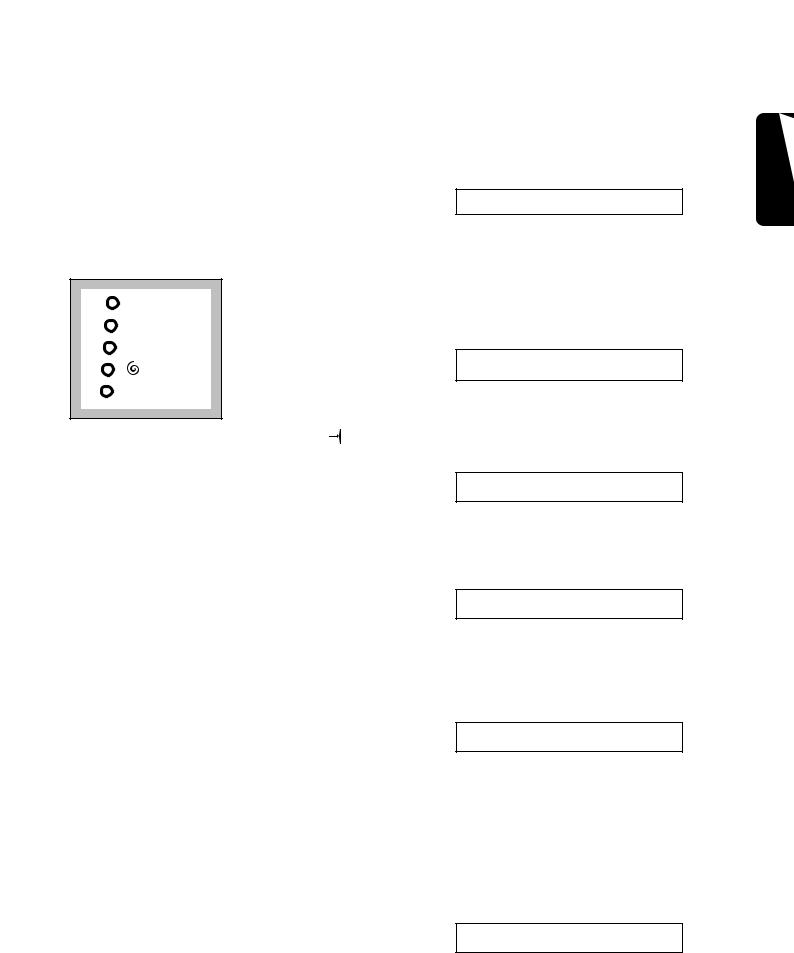
9 Programme progress display
By selecting the wash programme, the pilot lights corresponding to the various phases making up the programme come on.
After the machine has started, only the running phase pilot light stays on.
 PREWASH
PREWASH
 WASH
WASH
 RINSES
RINSES
DRAIN
 END
END
At the end of the programme the pilot light illuminates.
The pilot light  flashes in the event of operating problems and the relative alarm code appears on the display:
flashes in the event of operating problems and the relative alarm code appears on the display:
-E40 = the door has not been closed
-E20 = the machine does not empty
-E10 = the machine does not fill
To eliminate the problem, see paragraph “Something not working”.
Programme information
 Rinses
Rinses
With this programme it is possible to rinse and spin cotton garments which have been washed by hand. The machine performs 3 rinses, followed by a final spin at maximum speed.
The spin speed can be reduced by depressing button  . The final spin is foreseen only for cotton items as in the spin programme.
. The final spin is foreseen only for cotton items as in the spin programme.
 Drain
Drain
For emptying out the water of the last rinse in programmes with the Rinse hold  option.
option.
Turn first the programme selector dial to O, then select programme  and depress the START/PAUSE button.
and depress the START/PAUSE button.
 Spin
Spin
Separate long spin at max.speed for hand washed garments. It has to be used for cotton items. You can reduce the speed by means of button  to adapt it to the fabrics to be spun.
to adapt it to the fabrics to be spun.
 Delicate Spin
Delicate Spin
Separate short spin at 700 rpm for hand washed garments. It has to be used for synthetic, delicate, wool/handwashed, silk items. You can reduce the speed by means of button  to adapt it to the fabrics to be spun.
to adapt it to the fabrics to be spun.
 Mini programme
Mini programme
This is a complete programme that can be combined with the following options: spin speed reduction, no spin, rinse hold and delayed start.
To be used for laundry which is lightly soiled or which needs freshening up.
Max load 2.5 kg;
Washing temperature 30°C Programme duration 30 minutes Final spin speed 700 r.p.m.
O = Cancelling/OFF
To reset a programme and to switch off the machine turn the selector dial to O. Now can a new programme be selected.
ENGLISH
13
 Washing hints
Washing hints
Sorting the laundry
Follow the wash code symbols on each garment label and the manufacturer’s washing instructions. Sort the laundry as follows:
whites, coloureds, synthetics, delicates, woollens.
Temperatures
90° for normally soiled white cottons and linen (e.g. tea cloths, towels, tablecloths, sheets...)
60° for normally soiled, colour fast garments (e.g. shirts, night dresses, pyjamas....) in linen, cotton or synthetic fibres and for lightly soiled white cotton (e.g. underwear).
 (cold)for delicate items (e.g. net curtains), mixed 30°-40° laundry including synthetic fibres and
(cold)for delicate items (e.g. net curtains), mixed 30°-40° laundry including synthetic fibres and
woollens bearing the label «pure new wool, machine washable, non-shrink».
Before loading the laundry
Never wash whites and coloureds together. Whites may lose their “whiteness” in the wash.
New coloured items may run in the first wash; they should therefore be washed separately the first time.
Make sure that no metal objects are left in the laundry (e.g. hair clips, safety pins, pins).
Button up pillowcases, close zip fasteners, hooks and poppers. Tie any belts or long tapes.
Remove persistent stains before washing. Rub particularly soiled areas with a special detergent or detergent paste.
Treat curtains with special care. Remove hooks or tie them up in a bag or net.
Maximum loads
Recommended loads are indicated in the programme charts.
General rules:
Cotton, linen: drum full but not too tightly packed; Synthetics: drum no more than half full;
Delicate fabrics and woollens: drum no more than one third full.
Washing a maximum load makes the most efficient use of water and energy.
For heavily soiled laundry, reduce the load size.
Laundry weights
The following weights are indicative: |
|
bathrobe |
1200 g |
napkin |
100 g |
quilt cover |
700 g |
sheet |
500 g |
pillow case |
200 g |
tablecloth |
250 g |
towelling towel |
200 g |
tea cloth |
100 g |
night dress |
200 g |
ladies’ briefs |
100 g |
man’s work shirt |
600 g |
man’s shirt |
200 g |
man’s pyjamas |
500 g |
blouse |
100 g |
men’s underpants |
100 g |
Removing stains
Stubborn stains may not be removed by just water and detergent. It is therefore advisable to treat them prior to washing.
Blood: treat fresh stains with cold water. For dried stains, soak overnight in water with a special detergent then rub in the soap and water.
Oil based paint: moisten with benzine stain remover, lay the garment on a soft cloth and dab the stain; treat several times.
Dried grease stains: moisten with turpentine, lay the garment on a soft surface and dab the stain with the fingertips and a cotton cloth.
Rust: oxalic acid dissolved in hot water or a rust removing product used cold. Be careful with rust stains which are not recent since the cellulose structure will already have been damaged and the fabric tends to hole.
Mould stains: treat with bleach, rinse well (whites and fast coloureds only).
Grass: soap lightly and treat with bleach (whites and fast coloureds only).
Ball point pen and glue: moisten with acetone (*), lay the garment on a soft cloth and dab the stain.
Lipstick: moisten with acetone as above, then treat stains with methylated spirits. Remove any residual marks from white fabrics with bleach.
Red wine: soak in water and detergent, rinse and treat with acetic or citric acid, then rinse. Treat any
14

residual marks with bleach.
Ink: depending on the type of ink, moisten the fabric first with acetone (*), then with acetic acid; treat any residual marks on white fabrics with bleach and then rinse thoroughly.
Tar stains: first treat with stain remover, methylated spirits or benzine, then rub with detergent paste.
(*) do not use acetone on artificial silk.
Detergents and additives
Good washing results also depend on the choice of detergent and use of the correct quantities to avoid waste and protect the environment. Although biodegradable, detergents contain substances which, in large quantities, can upset the delicate balance of nature.
The choice of detergent will depend on the type of fabric (delicates, woollens, cottons, etc.), the colour, washing temperature and degree of soiling.
All commonly available washing machine detergents may be used in this appliance:
–powder detergents for all types of fabric,
–powder detergents for delicate fabrics (60°C max) and woollens,
–liquid detergents, preferably for low temperature wash programmes (60°C max) for all types of fabric, or special for woollens only.
The detergent and any additives must be placed in the appropriate compartments of the dispenser drawer before starting the wash programme.
If using concentrated powder or liquid detergents, a programme without prewash must be selected.
The washing machine incorporates a recirculation system which allows an optimal use of the concentrated detergent.
Pour liquid detergent into the dispenser drawer compartment marked  just before starting the programme.
just before starting the programme.
Any fabric softener or starching additives must be poured into the compartment marked  before starting the wash programme.
before starting the wash programme.
The bleaching agent (chlorine) can be used only for white or fast coloured cotton and linen items.
Pour it into the compartment marked  .
.
Follow the product manufacturer’s recommendations on quantities to use and do not exceed the «MAX» mark in the detergent dispenser drawer.
Quantity of detergent to be used
The type and quantity of detergent will depend on the type of fabric, load size, degree of soiling and hardness of the water used.
Water hardness is classified in so-called “degrees” of hardness. Information on hardness of the water in your area can be obtained from the relevant water supply company, or from your local authority.
Follow the product manufacturers’ instructions on quantities to use.
Use less detergent if:
–you are washing a small load,
–the laundry is lightly soiled,
–large amounts of foam form during washing.
Degrees of water hardness
|
|
Degrees |
||
Level |
Characteristic |
|
|
|
German |
French |
|||
|
|
|||
|
|
°dH |
°T.H. |
|
|
|
|
|
|
1 |
soft |
0- 7 |
0-15 |
|
|
|
|||
2 |
medium |
8-14 |
16-25 |
|
|
|
|||
3 |
hard |
15-21 |
26-37 |
|
|
|
|||
4 |
very hard |
more than |
more than |
|
21 |
37 |
|||
|
|
|||
|
|
|
|
|
ENGLISH
15
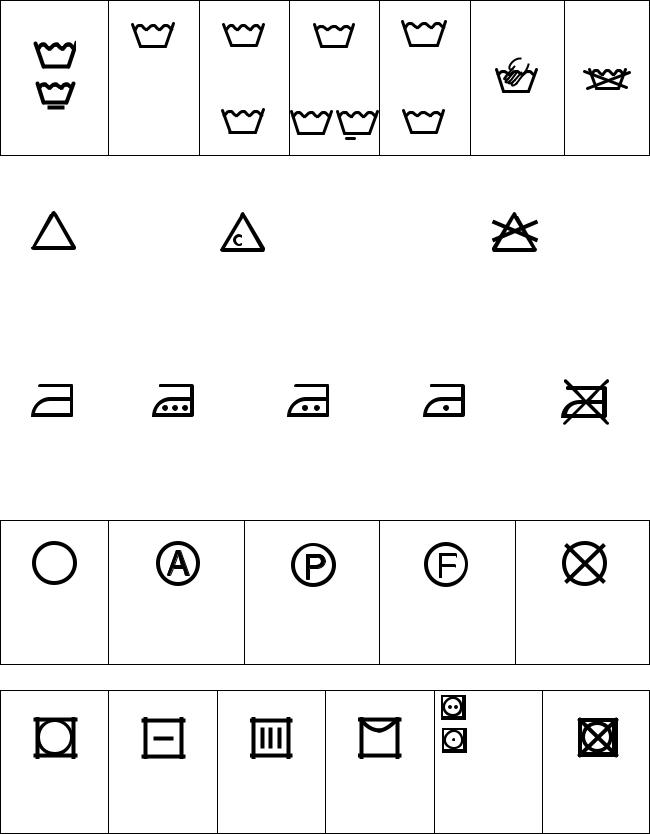
 International wash code symbols
International wash code symbols
These symbols appear on fabric labels, in order to help you choose the best way to treat your laundry.
Energetic wash |
|
|
|
30 |
|
|
95 |
60 |
|
40 |
|
|
|
Max. wash |
Max. wash |
Max. wash |
Max. wash |
|
|
|
temperature |
temperature |
temperature |
temperature |
|
|
|
95°C |
60°C |
|
40°C |
30°C |
|
|
|
60 |
40 |
40 |
30 |
Hand wash |
Do not |
Delicate wash |
|
wash |
||||
|
|
|
|
|
|
at all |
Bleaching |
|
|
|
|
|
|
|
Bleach in cold water |
Do not bleach |
||
|
|
|
|
Ironing |
Hot iron |
Warm iron |
Lukewarm iron |
Do not iron |
||||
|
max 200°C |
max 150°C |
max 110°C |
|
||||
|
|
|
|
|
|
|
|
|
|
|
|
|
|
|
|
|
|
|
|
|
|
|
|
|
|
|
|
|
|
|
|
|
|
|
|
|
|
|
|
|
|
|
|
|
Dry cleaning |
Dry cleaning |
Dry cleaning in |
Dry cleaning |
Do not |
|
in all solvents |
perchlorethylene, |
in petrol, |
dry clean |
|
|
petrol, pure alcohol, |
pure alcohol |
|
|
|
R 111 & R 113 |
and R 113 |
|
|
|
|
|
high |
|
|
|
|
|
temperature |
|
|
|
|
|
low |
|
|
|
|
|
temperature |
|
Drying |
Flat |
On the line |
On clothes |
Tumble dry |
Do not |
|
|
|
hanger |
|
tumble dry |
16
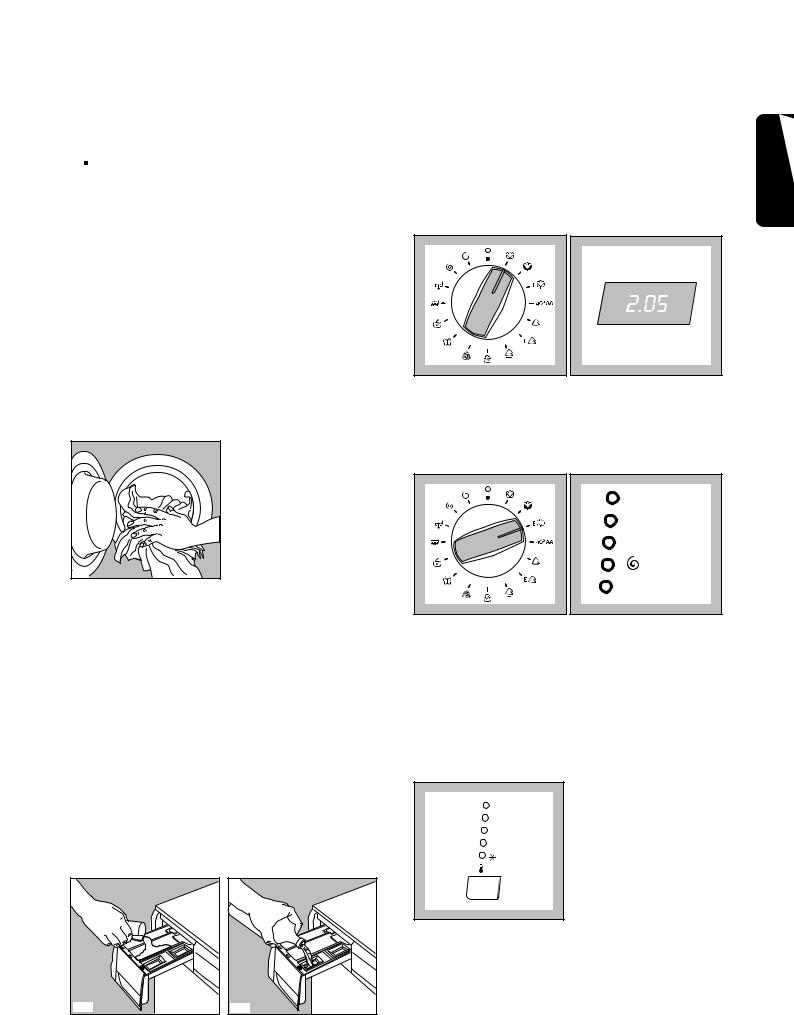
 Operating sequence
Operating sequence
Before washing your first load of laundry, we recommend that you run a cotton cycle at 90°C, with the machine empty, in order to remove any manufacturing residue from the drum and tub.
Pour half a measure of detergent into the main wash compartment and start up the machine.
1. Place the laundry in the drum
Open the door.
Place the laundry in the drum, one item at a time, shaking them out as much as possible.
Close the door.
P0004
2. Measure out the detergent
Pull out the dispenser drawer until it stops. Measure out the amount of detergent recommended by the manufacturer in a graduated cup and pour it into the main wash compartment  .
.
If you wish to carry out a programme with prewash, pour detergent into the appropriate compartment marked  .
.
3. Measure out the additives
If required, pour fabric softener into the compartment marked  and the bleach into the compartement marked
and the bleach into the compartement marked  , without exceeding the «MAX» mark.
, without exceeding the «MAX» mark.
C0116 |
C0117 |
4. Switch the machine ON
Turn the selector dial to the desired programme to switch the appliance on.
To switch the appliance off turn it to «O».
5. Select the desired programme
Turn the selector dial to the desired position: the lights corresponding to the different phases making up the selected programme light on.
 PREWASH
PREWASH
 WASH
WASH
 RINSES
RINSES
DRAIN
 END
END
The duration of the programme appears in the display.
6. Select the temperature 
Press the Temperature button  if you wish to select a temperature value different
if you wish to select a temperature value different
from the one proposed by the washing machine. The relevant light will light up.
90°
60°
40°
30°
ENGLISH
17
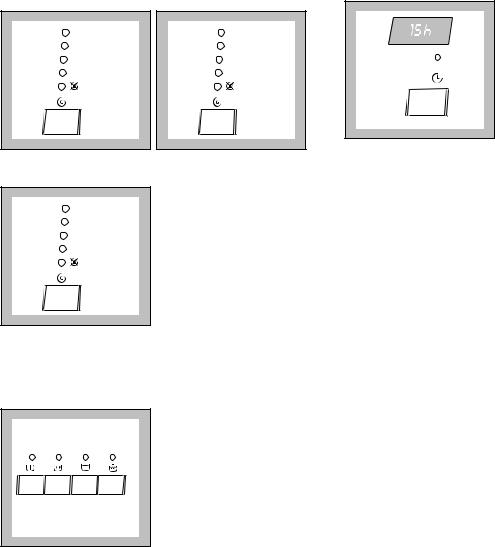
7.Select the Spin Speed  or the NO SPIN
or the NO SPIN  option.
option.
Press the SPIN SPEED button repeatedly, in
order to select the desired spin speed or the No spin  option. The relevant light will light up.
option. The relevant light will light up.
EWF 735 |
EWF 935 |
700 |
900 |
600 |
700 |
500 |
600 |
450 |
500 |
EWF 1035
1000 900 700 500
8. Select the desired options
The light corresponding to the depressed button illuminates.
If you select the Rinse hold  option, the machine will stop at the end of the programme with the water still in the tub.
option, the machine will stop at the end of the programme with the water still in the tub.
9. Select the DELAY START 
To delay starting of the programme, press the DELAY start button. The figures corresponding to the selected delay will be displayed for about 3 seconds, after which the duration of the selected programme will appear on the display.
During this period it is possible to load other laundry:
•depress START/PAUSE button  ;
;
•open the door;
•load the laundry;
•close the door and depress START/PAUSE button
 again.
again.
10. Start the programme
Press the START/PAUSE button  . The relevant light will stop flashing and only
. The relevant light will stop flashing and only
the light relevant to the phase that is in progress will remain lit.
If you have chosen a delayed start, the washing machine will begin the countdown.
The display will show the duration of the programme or the selected delay.
18

11. How to change an option or a programme during its cycle
Before you make any change, you must pause the machine by pressing the START/PAUSE button  .
.
It is possible to change the temperature or any phase before the programme carries it out.
Changing a running programme is possible only by cancelling it and selecting a new programme.
The machine will resume the cycle from the beginning and the washing water in the tub will not emptied out.
If it is necessary to drain the water in order to change the programme in progress, proceed as follows:
•turn the programme selector dial to «O»;
•select programme  ;
;
•press the START/PAUSE  button again.
button again.
When the water has been drained, the display shows a blinking zero and the light  light on.
light on.
You may now select a new programme and press the START/PAUSE button  to start it.
to start it.
12. Interrupting a programme
Depress the START/PAUSE button  to interrupt a programme which is running, the
to interrupt a programme which is running, the
corresponding light starts to flash. Depress the same button again to restart the programme.
13. Cancelling a programme
Turn the selector dial to «O» to cancel a programme which is running. Now you can select a new programme.
14.How to open the door after the programme has started
First set the machine to PAUSE by pressing the START/PAUSE button  .
.
If the door does not open, this means that the machine is already heating, that the water level is above the bottom edge of the door or that the drum is turning.
If you cannot open the door but you need to open it you have to switch the machine off turning the selector dial to «O» . After about 3 minutes the door can be opened (pay attention to the water level and temperature!). To restart the programme switch on the machine and select again the desired programme and options.
15. At the end of the programme
The washing machine stops automatically.
If the Rinse hold  option has been selected, the door is blocked, the light of the START/PAUSE button
option has been selected, the door is blocked, the light of the START/PAUSE button  goes off,
goes off,  and
and  remain lit, to indicate that the water must be drained before opening the door. The display shows a flashing zero.
remain lit, to indicate that the water must be drained before opening the door. The display shows a flashing zero.
There are 2 possibilities to empty out water:
• Select programme  (draining):
(draining):
The water is emptied out without spinning.
•Select programme  or
or  . Select the spin speed by means of the relevant button and then
. Select the spin speed by means of the relevant button and then
depress the START/PAUSE button  . The water is emptied out and the laundry is spun at the selected spin speed.
. The water is emptied out and the laundry is spun at the selected spin speed.
Attention! Before selecting programme  ,
,
and the selector dial has to be positioned on 0 (cancelling).
Turn the programme selector dial to Reset «O» to switch the machine off.
Remove the laundry from the drum and carefully check that the drum is empty so as to avoid any forgotten items being damaged in a subsequent wash (e.g. shrinking) or their colour running into a load of whites.
If you do not intend to carry out another wash, close the water tap.
Leave the door open to prevent the formation of mildew and unpleasant smells.
ENGLISH
19

Programme table
Washing Programmes for cottons |
and synthetics |
|
|
|||||
|
|
|
|
|
|
|
|
|
|
Max |
Programme/ |
Description of |
|
Consumption* |
|||
Type of laundry |
Available options |
|
|
|
||||
load |
temperature |
programme |
Energy |
Water |
Time |
|||
|
|
|
|
|
|
kWh |
litres |
h/min. |
|
|
|
|
|
|
|
|
|
White cotton: e.g. |
|
White cotton |
Main wash at |
|
|
|
|
|
sheets, tablecloths, |
|
|
|
(cold)-90°C |
|
|
|
|
household linen |
5 kg |
|
(cold)-90°C |
3 rinses |
|
2.0 |
53 |
2.25 |
|
|
|
||||||
|
|
|
|
Long spin |
|
|
|
|
|
|
|
|
|
|
|
|
|
Coloured cotton: |
|
|
Coloured |
Main wash at |
|
|
|
|
e.g. shirts, blouses, |
|
Cotton |
(cold)-60°C |
|
|
|
|
|
underwear, towels, |
5 kg |
|
(cold)-60°C |
3 rinses |
|
1.2 |
49 |
2.00 |
house-hold linen |
|
Long spin |
|
|||||
|
|
|
|
|
|
|
|
|
Cottons |
|
|
Cottons |
Main wash at |
|
|
|
|
ECONOMY**: e.g. |
6 kg |
ECONOMY |
E 60°/40°C |
|
|
|
|
|
shirts, blouses, |
E 60°/40°C |
2 rinses |
|
1.14 |
49 |
2.21 |
||
underwear |
|
|
E |
Long spin |
|
|
|
|
|
|
|
|
|
|
|
|
|
White/Coloured |
|
White/coloured |
Main wash at |
|
|
|
|
|
Cottons 40°AA*** |
5 kg |
|
cotton |
40°C |
|
|
|
|
|
|
40°AA |
3 rinses |
|
0.95 |
49 |
2.20 |
|
|
|
|
Long spin |
|
|
|
|
|
|
|
|
|
|
|
|
|
|
|
|
|
|
|
|
|
|
|
Synthetics: e.g. |
|
Synthetics |
Main wash at |
|
|
|
|
|
shirts, blouses, |
|
(cold)-40°C |
|
|
|
|
||
2.5 kg |
|
(cold)-60°C |
|
0.9 |
54 |
1.33 |
||
underwear |
|
3 rinses |
|
|||||
|
|
|
|
Short spin |
|
|
|
|
|
|
|
|
|
|
|
|
|
Synthetics |
|
|
Synthetics |
Main wash at |
|
|
|
|
2.5 kg |
ECONOMY |
E 40°C |
|
|
|
|
||
ECONOMY |
E |
E40°C |
3 rinses |
|
0.45 |
54 |
1.24 |
|
|
|
|
|
Short spin |
|
|
|
|
|
|
|
|
|
|
|
|
|
*The consumption data shown on this chart is to be considered purely indicative, as it may vary depending on the quantity and type of laundry, on the inlet water temperature and on the ambient temperature. It refers to the highest temperature for each wash programme.
**In compliance with EC directive 92/75 the consumption figures indicated on the Energy label refer to this programme E  at 60°C.
at 60°C.
***Fabrics washed with this programme have a washing efficiency result of AA.
The wool wash cycle of this machine has been approved by Woolmark for the washing of machine washable Woolmark products provided that the garments are washed according to the instructions on the garment label and those issued by the manufacturer of this machine. Licence No. M9604.
20
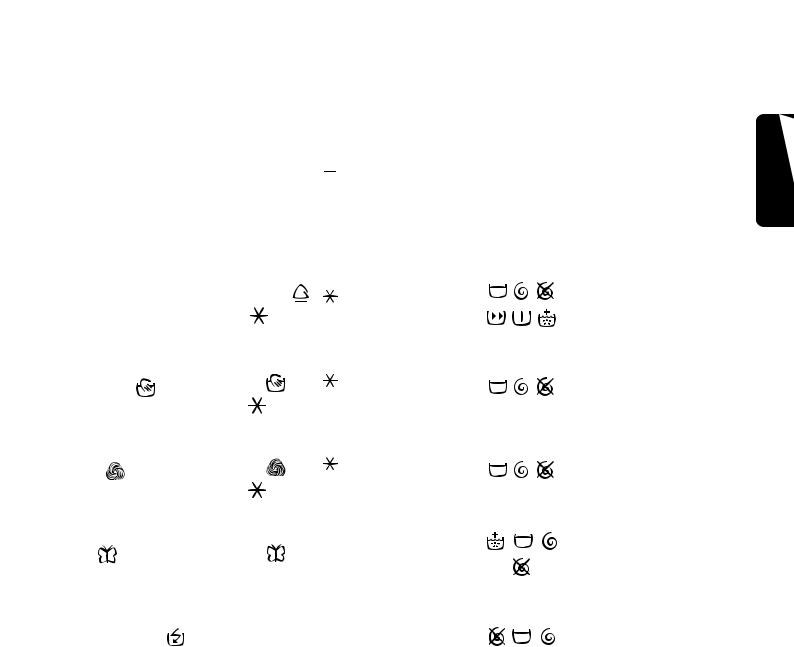
Programme table
Washing programmes for delicates  , handwash
, handwash  , wool
, wool  and silk
and silk 
Type of laundry |
Max |
Programme/ |
Description of |
Available |
Consumption |
||
|
|
|
|||||
load |
temperature |
programme |
options |
Energy |
Water |
Time |
|
|
kWh |
litres |
h/min. |
||||
|
|
|
|
|
|||
|
|
|
|
|
|
|
|
Delicates: e.g. |
|
|
Main wash at |
|
|
|
|
acrylic fabrics, |
2,5 kg |
Delicates |
(cold)-40°C |
|
0.5 |
55 |
1.00 |
viscose, polyester, |
|
-40°C |
3 rinses |
|
|
|
|
synthetic blends |
|
|
Short spin |
|
|
|
|
|
|
|
|
|
|
|
|
|
|
Handwash |
Main wash at |
|
|
|
|
Handwash |
2 kg |
|
(cold)-40°C |
|
0.35 |
55 |
56 |
|
3 rinses |
|
|||||
|
|
- 40°C |
|
|
|
|
|
|
|
Short spin |
|
|
|
|
|
|
|
|
|
|
|
|
|
|
|
Wool |
Main wash at |
|
|
|
|
Wool |
2 kg |
|
(cold)-40°C |
|
0.35 |
55 |
55 |
|
3 rinses |
|
|||||
|
|
- 40°C |
|
|
|
|
|
|
|
Short spin |
|
|
|
|
|
|
|
|
|
|
|
|
|
|
|
Silk |
Main wash at 30°C |
|
|
|
|
Silk |
1 kg |
|
3 rinses |
|
0.30 |
53 |
40 |
|
|
30°C |
Short spin |
|
|
|
|
|
|
|
|
|
|
|
|
|
|
Mini- |
Main wash at 30°C |
|
|
|
|
Miniprogramme |
2,5 kg |
programme |
2 rinses |
|
0.3 |
40 |
30 |
|
|
30°C |
Short spin |
|
|
|
|
|
|
|
|
|
|
|
|
ENGLISH
21
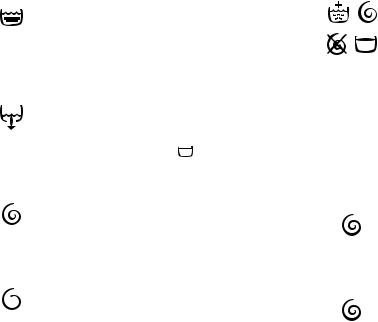
Programme table
Special Programmes
Programme |
|
Programme |
Addictional |
Wash |
Consumption* |
||
|
|
|
|
||||
selector dial |
Programme |
description |
functions |
load |
Energy |
Water |
Time |
position |
|
max. |
|||||
|
|
|
kWh |
litres |
min. |
||
|
|
|
|
|
|||
|
|
|
|
|
|
|
|
|
|
3 rinses with |
|
|
|
|
|
|
|
liquid additive, |
|
5 kg |
|
|
|
|
For rinsing items |
if required. |
|
0.08 |
45 |
45 |
|
Rinses |
|
Long spin at |
|
|
|
|
|
|
|
max. speed |
|
|
|
|
|
|
|
|
|
|
|
|
|
|
For empting out the |
|
|
|
|
|
|
|
water of the last |
Water draining |
|
/ |
- |
- |
2 |
Drain |
rinses of program- |
|
|||||
mes with option |
|
|
|
|
|
|
|
|
|
|
|
|
|
|
|
|
Separate spin for |
Drain and spin |
|
5 kg |
|
|
|
|
at the max. |
|
- |
- |
10 |
||
Spin |
cottons |
|
|||||
|
speed |
|
|
|
|
|
|
|
|
|
|
|
|
|
|
|
Separate spin for |
Drain and |
|
|
|
|
|
|
synthetics, delicates, |
|
5 kg |
- |
- |
6 |
|
Delicate Spin |
wool/handwash and |
delicate spin |
|
||||
silk |
|
|
|
|
|
|
|
|
|
|
|
|
|
|
|
O |
For cancelling the |
|
|
|
|
|
|
programme which is |
|
|
/ |
- |
- |
- |
|
Reset/Off |
running or to switch |
|
|
||||
the machine off. |
|
|
|
|
|
|
|
|
|
|
|
|
|
|
|
|
|
|
|
|
|
|
|
22
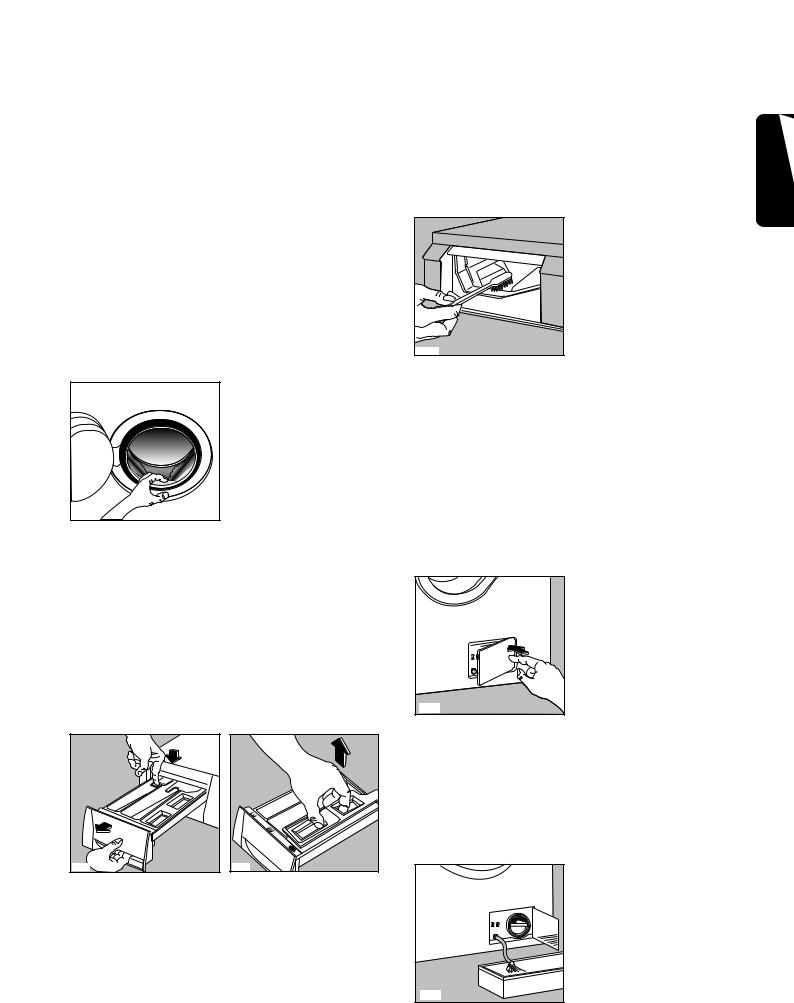
Maintenance
1. Bodywork
Clean the outside of the machine with soap and water only. Rinse with clean water and dry with a soft cloth.
Important: do not use methylated spirits, solvents or similar products to clean the bodywork.
2. Door seal
Check from time to time the door seal and eliminate eventual possible objects that could be trapped in the fold.
Detergent can also accumulate inside the drawer recess: clean it with an old toothbrush. Refit the drawer after cleaning.
P0038 |
P1050
3. Detergent dispenser drawer
After a while, detergents and fabric softeners leave deposits in the drawer.
Clean the drawer from time to time by rinsing it under a running tap. To remove the drawer from the machine, press the button in the rear left-hand corner.
To facilitate cleaning, the top part of the additive compartments can be removed.
C0118 |
C0119 |
4. Drain pump
The pump should be inspected if
•the machine does not empty and/or spin
•the machine makes an unusual noise during draining due to objects such as safety pins, coins etc. blocking the pump.
Proceed as follows:
•Disconnect the appliance.
•If necessary wait until the water has cooled down.
•Open the pump door.
P1114 |
•Place a container close to the pump to collect any spillage.
•Release the emergency emptying hose, place it in the container and remove its cap.
•When no more water comes out, unscrew the pump cover and remove the pump. Always keep a rag nearby to dry up spillage of water when removing the pump.
P1115
ENGLISH
23

•Remove any objects from the pump impeller by rotating it.
•Put the cap back on the emergency emptying hose and place the latter back in its seat.
P1117 |
•Screw the pump cover fully in.
•Close the pump door.
5. Water inlet filter
If you notice that the machine is taking longer to fill, check that the filter in the water inlet hose is not blocked.
Turn off the water tap. Unscrew the hose from the tap.
Clean the filter with a stiff brush. Screw the hose back onto the tap.
P1090 |
6. Emergency emptying out
If the water is not discharged, proceed as follows to empty out the machine:
•pull out the plug from the power socket;
•close the water tap;
•if necessary, wait until the water has cooled down;
•open the pump door;
•place a bowl on the floor and place the end of the emergency emptying hose into the bowl. Remove its cap. The water should drain by gravity into the bowl. Whe the bowl is full, put the cap back on the hose. Empty the bowl. Repeat the procedure until water stops flowing out;
•clean the pump if necessary as previously described;
•replace the emergency emptying hose in its seat after having plugged it;
•screw the pump cover again and close the door.
7. Frost precautions
If the machine is installed in a place where the temperature could drop below 0°C, proceed as follows:
•Remove the plug from the socket.
•Close the water tap and unscrew the water inlet hose from the tap.
•Place the end of the emergency emptying hose and that of the inlet hose in a bowl placed on the floor and let water drain out.
•Screw the water inlet hose back on and reposition the emergency emptying hose after having put the cap on again.
By doing this, any water remaining in the machine is removed, avoiding the formation of ice and, consequently, breakage of the affected parts.
When you use the machine again, make sure that the ambient temperature is above 0°C.
Important!
Every time you drain the water through the emergency emptying hose you must pour 2 litres of water into the main wash compartment of the detergent drawer and then run the drain programme. This will activate the ECO VALVE device avoiding that part of the detergent remains unused at next washing.
24
